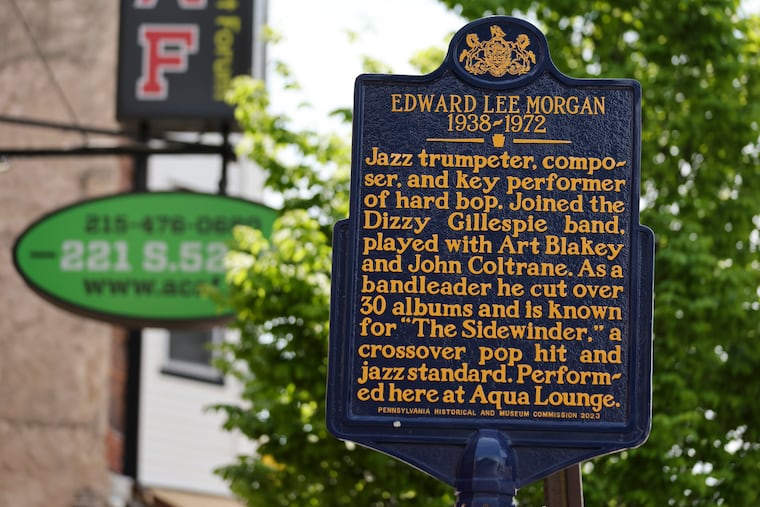Philly jazz legend Lee Morgan honored with a new historical marker
The story of Morgan's tragic death at 33 has long eclipsed his remarkable career. The marker is one attempt to right that balance.

In October 1971, trumpeter Lee Morgan made what turned out to be his final hometown appearance, leading his band at the Aqua Lounge, a club on the stretch of 52nd Street in West Philly then known as “Black Main Street.” To celebrate International Jazz Day on Tuesday, members of the Philadelphia jazz community and local leaders gathered on the same site — now the African Cultural Art Forum — to unveil a historical marker commemorating Morgan’s accomplishments.
Among the crowd was fellow trumpeter Andy Aaron, now 87, who had caught the tail end of Morgan’s set following a gig with his own band, the Mean Machine, a few blocks away. “I knew Lee from before he went to New York,” he recalled. “It was always fascinating to watch him. You had to really see him to see the intensity.”
Aaron ended up giving Morgan and his companion, Helen Moore, a ride back to Germantown that night. No one in the car could have known that Morgan would be dead four months later, shot by Moore at New York’s East Village club Slugs’ Saloon. That tragic death has long eclipsed Morgan’s life, which began in the Tioga neighborhood and rose to musical heights during his too-brief 33 years.
The marker is one attempt to right that balance. Its familiar gold text on blue background cites accomplishments like playing with Art Blakey and John Coltrane, and releasing the soul-jazz classic The Sidewinder.
Twenty-five miles to the northeast, in Feasterville, another marker stands in remembrance of Morgan’s life and death: the grave marker shared by the jazz legend and his father, Otto Morgan. In White Chapel Memorial Park, a battered white trumpet sitting atop the simple headstone makes the site relatively easy to find, despite the nearly knee-high grass and rutted driveway leading to it. The grave has long been listed on site maps and the location was never lost. But in 2021, when local fan Tommy Maguire went to pay his respects, the gravesite wasn’t visible.
“I didn’t know much about Lee Morgan, to be honest,” recalled Maguire. He’d delved deep into the trumpeter’s work during the pandemic, after seeing the 2016 documentary I Called Him Morgan.
“Then at some point in the middle of all that obsession, I read that he was buried somewhere in Philadelphia.”
Maguire works as the manager of the graphics team for a credit card company but, with his shock of gray hair, he could be mistaken for a middle-aged rocker. He mentions his “bazillion vinyl records” with the obsessive’s slight eye-roll, and seems to have a penchant for seeking out his favorites’ final resting places and other related sites.
A recent trip to London invited a search for T. Rex front man Marc Bolan’s former flat, and a current passion project is trying to remedy the lack of a headstone for bop pianist Bud Powell at Willow Grove’s Fairview Cemetery.
Maguire’s first visit to White Chapel Memorial Park was simply to pay his respects. So were the two follow-ups, each one ending in frustration when he failed to see the grave where it should have been. On his fourth visit, in late December 2021 with his family in tow, he enlisted the help of groundskeeper Calwin Tracey.
“I’m sure he wasn’t real pleased to have to take this weird guy and his kids to find this trumpet player’s grave,” Maguire reflected with a laugh. “He was a man of few words but we followed him, and he suddenly got completely perplexed. He looked at me and said, ‘It’s here. It’s right here.’ And I said, ‘But it’s not.’”
Tracey returned with a long crowbar, which he plunged into the ground on the spot — and was rewarded with a metallic clang. Remarkably, uncovering the marker took almost half an hour of digging to remove the foot-or-so of ground that had swallowed the headstone.
» READ MORE: Pa.’s historical markers help teach Black history. Don’t let culture wars interfere
“It needs to be fixed up. And [add] a bench here so people could see it,” Tracey said to Inquirer photographer Tom Gralish. “I wish they could do something.”
The crowd that thronged 52nd Street on Tuesday included members of Morgan’s family, local jazz musicians, promoters, historians, educators, and longtime fans, many of them clutching well-worn copies of the trumpeter’s Blue Note LPs and sporting T-shirts reproducing their iconic covers. Proclamations were read from Mayor Cherelle L. Parker, Gov. Josh Shapiro, Sen. Bob Casey, and other local politicians, and a brief appreciation was offered by saxophonist Billy Harper, who had been a member of Morgan’s band that night at the Aqua Lounge.
After the ceremony, Harper squinted up at the building, attempting to conjure a memory of its former incarnation after five decades and countless venues. “I feel lifted up,” he remarked on the occasion.
The marker, and the recent induction of Morgan’s 1963 album, The Sidewinder, into the National Recording Registry, can be credited to historic preservationist Faye Anderson, founder of the website All That Philly Jazz. Fanning herself from the intense sun on Tuesday afternoon, Anderson sounded relieved to finally see the sign in place. “It feels great,” she said. “My goal was to change the conversation from how Lee Morgan died to how he lived.”
Update: This story has been updated to clarify that the grave of Lee Morgan was never lost, but simply covered over.